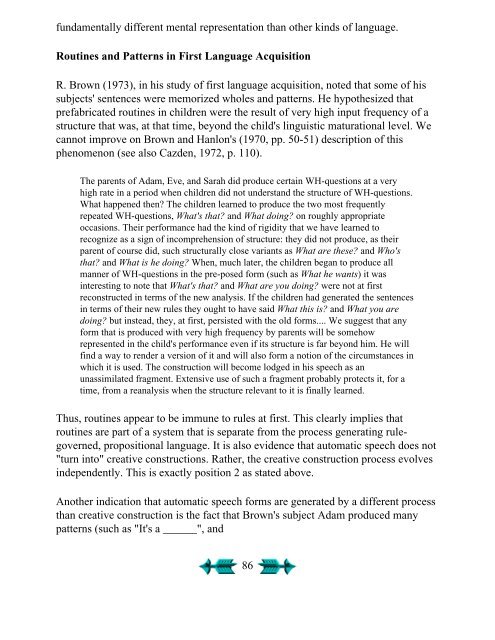Second Language Acquisition and Second ... - Stephen Krashen
Second Language Acquisition and Second ... - Stephen Krashen
Second Language Acquisition and Second ... - Stephen Krashen
You also want an ePaper? Increase the reach of your titles
YUMPU automatically turns print PDFs into web optimized ePapers that Google loves.
fundamentally different mental representation than other kinds of language.<br />
Routines <strong>and</strong> Patterns in First <strong>Language</strong> <strong>Acquisition</strong><br />
R. Brown (1973), in his study of first language acquisition, noted that some of his<br />
subjects' sentences were memorized wholes <strong>and</strong> patterns. He hypothesized that<br />
prefabricated routines in children were the result of very high input frequency of a<br />
structure that was, at that time, beyond the child's linguistic maturational level. We<br />
cannot improve on Brown <strong>and</strong> Hanlon's (1970, pp. 50-51) description of this<br />
phenomenon (see also Cazden, 1972, p. 110).<br />
The parents of Adam, Eve, <strong>and</strong> Sarah did produce certain WH-questions at a very<br />
high rate in a period when children did not underst<strong>and</strong> the structure of WH-questions.<br />
What happened then? The children learned to produce the two most frequently<br />
repeated WH-questions, What's that? <strong>and</strong> What doing? on roughly appropriate<br />
occasions. Their performance had the kind of rigidity that we have learned to<br />
recognize as a sign of incomprehension of structure: they did not produce, as their<br />
parent of course did, such structurally close variants as What are these? <strong>and</strong> Who's<br />
that? <strong>and</strong> What is he doing? When, much later, the children began to produce all<br />
manner of WH-questions in the pre-posed form (such as What he wants) it was<br />
interesting to note that What's that? <strong>and</strong> What are you doing? were not at first<br />
reconstructed in terms of the new analysis. If the children had generated the sentences<br />
in terms of their new rules they ought to have said What this is? <strong>and</strong> What you are<br />
doing? but instead, they, at first, persisted with the old forms.... We suggest that any<br />
form that is produced with very high frequency by parents will be somehow<br />
represented in the child's performance even if its structure is far beyond him. He will<br />
find a way to render a version of it <strong>and</strong> will also form a notion of the circumstances in<br />
which it is used. The construction will become lodged in his speech as an<br />
unassimilated fragment. Extensive use of such a fragment probably protects it, for a<br />
time, from a reanalysis when the structure relevant to it is finally learned.<br />
Thus, routines appear to be immune to rules at first. This clearly implies that<br />
routines are part of a system that is separate from the process generating rulegoverned,<br />
propositional language. It is also evidence that automatic speech does not<br />
"turn into" creative constructions. Rather, the creative construction process evolves<br />
independently. This is exactly position 2 as stated above.<br />
Another indication that automatic speech forms are generated by a different process<br />
than creative construction is the fact that Brown's subject Adam produced many<br />
patterns (such as "It's a ______", <strong>and</strong><br />
86











